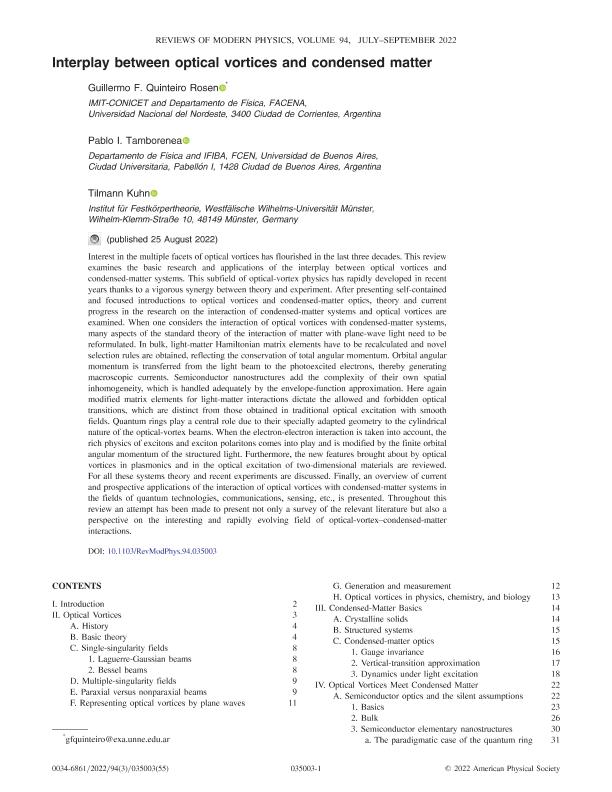Mostrar el registro sencillo del ítem
dc.contributor.author
Quinteiro, Guillermo Federico

dc.contributor.author
Tamborenea, Pablo Ignacio

dc.contributor.author
Kuhn, Tilmann
dc.date.available
2023-09-01T10:30:12Z
dc.date.issued
2022-07
dc.identifier.citation
Quinteiro, Guillermo Federico; Tamborenea, Pablo Ignacio; Kuhn, Tilmann; Interplay between optical vortices and condensed matter; American Physical Society; Reviews Of Modern Physics; 94; 3; 7-2022; 1-55
dc.identifier.issn
0034-6861
dc.identifier.uri
http://hdl.handle.net/11336/210122
dc.description.abstract
Interest in the multiple facets of optical vortices has flourished in the last three decades. This review examines the basic research and applications of the interplay between optical vortices and condensed-matter systems. This subfield of optical-vortex physics has rapidly developed in recent years thanks to a vigorous synergy between theory and experiment. After presenting self-contained and focused introductions to optical vortices and condensed-matter optics, theory and current progress in the research on the interaction of condensed-matter systems and optical vortices are examined. When one considers the interaction of optical vortices with condensed-matter systems, many aspects of the standard theory of the interaction of matter with plane-wave light need to be reformulated. In bulk, light-matter Hamiltonian matrix elements have to be recalculated and novel selection rules are obtained, reflecting the conservation of total angular momentum. Orbital angular momentum is transferred from the light beam to the photoexcited electrons, thereby generating macroscopic currents. Semiconductor nanostructures add the complexity of their own spatial inhomogeneity, which is handled adequately by the envelope-function approximation. Here again modified matrix elements for light-matter interactions dictate the allowed and forbidden optical transitions, which are distinct from those obtained in traditional optical excitation with smooth fields. Quantum rings play a central role due to their specially adapted geometry to the cylindrical nature of the optical-vortex beams. When the electron-electron interaction is taken into account, the rich physics of excitons and exciton polaritons comes into play and is modified by the finite orbital angular momentum of the structured light. Furthermore, the new features brought about by optical vortices in plasmonics and in the optical excitation of two-dimensional materials are reviewed. For all these systems theory and recent experiments are discussed. Finally, an overview of current and prospective applications of the interaction of optical vortices with condensed-matter systems in the fields of quantum technologies, communications, sensing, etc., is presented. Throughout this review an attempt has been made to present not only a survey of the relevant literature but also a perspective on the interesting and rapidly evolving field of optical-vortex-condensed-matter interactions.
dc.format
application/pdf
dc.language.iso
eng
dc.publisher
American Physical Society

dc.rights
info:eu-repo/semantics/openAccess
dc.rights.uri
https://creativecommons.org/licenses/by-nc-sa/2.5/ar/
dc.subject
optical vortices
dc.subject
semiconductors
dc.subject
nanostructures
dc.subject
light-matter interaction
dc.subject.classification
Física de los Materiales Condensados

dc.subject.classification
Ciencias Físicas

dc.subject.classification
CIENCIAS NATURALES Y EXACTAS

dc.title
Interplay between optical vortices and condensed matter
dc.type
info:eu-repo/semantics/article
dc.type
info:ar-repo/semantics/artículo
dc.type
info:eu-repo/semantics/publishedVersion
dc.date.updated
2023-07-07T19:18:01Z
dc.journal.volume
94
dc.journal.number
3
dc.journal.pagination
1-55
dc.journal.pais
Estados Unidos

dc.description.fil
Fil: Quinteiro, Guillermo Federico. Consejo Nacional de Investigaciones Científicas y Técnicas. Centro Científico Tecnológico Conicet - Nordeste. Instituto de Modelado e Innovación Tecnológica. Universidad Nacional del Nordeste. Facultad de Ciencias Exactas Naturales y Agrimensura. Instituto de Modelado e Innovación Tecnológica; Argentina
dc.description.fil
Fil: Tamborenea, Pablo Ignacio. Consejo Nacional de Investigaciones Científicas y Técnicas. Oficina de Coordinación Administrativa Ciudad Universitaria. Instituto de Física de Buenos Aires. Universidad de Buenos Aires. Facultad de Ciencias Exactas y Naturales. Instituto de Física de Buenos Aires; Argentina
dc.description.fil
Fil: Kuhn, Tilmann. Westfälische Wilhelms Universität; Alemania
dc.journal.title
Reviews Of Modern Physics

dc.relation.alternativeid
info:eu-repo/semantics/altIdentifier/doi/http://dx.doi.org/10.1103/RevModPhys.94.035003
Archivos asociados
